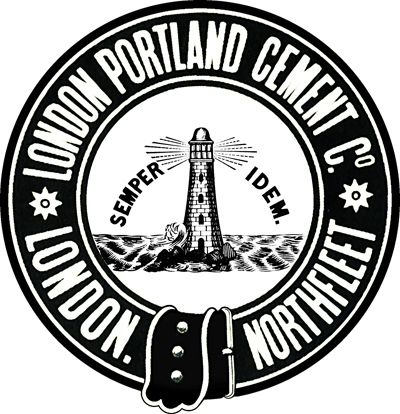
London Portland Cement Co. Ltd. Lighthouse Brand.
Location:
- Grid reference: TQ62467460
- x=562460
- y=174600
- 51°26'50"N; 0°20'17"E
- Civil Parish: Northfleet, Kent
Clinker manufacture operational: 1868-1908
Approximate total clinker production: 870,000 tonnes
Raw materials:
- Upper Chalk (Seaford Chalk Formation: 85-88 Ma) from quarry at 562300,174000
- Thames and Medway Alluvial Clay
Ownership:
- 1868-1876 J. C. Gostling and Co. Ltd
- 1876-1900 London Portland Cement Co. Ltd
- 1900-1908 APCM (Blue Circle)
There were seven bottle kilns (around 200 t/week) until these were replaced by 38 chamber kilns (output 1000 t/week) during 1889-1891. There was no rail link, and all product was despatched by barge. After closure, the raw- and finish mills were retained as backup capacity for the adjacent Bevans plant, as described in the 1924 schedule. The chamber kilns were located on what was later the site of the cold ends of Northfleet kilns A5 and A6, and the whole site disappeared beneath the buildings and paving of that plant.
Power supply
Originally, all equipment was direct driven by steam engines. From around 1900, the finish mills were driven by gas engine. After 1905, electric power from the Bevans power house was used to drive the rawmills.
Rawmills
The early plant is unknown, but finally there were one rough- and one intermediate washmill, followed by six Clarke's screeners. The rawmills continued in operation for some time after kiln closure to supplement Bevans slurry requirements.
No rotary kilns were installed.
Sources:
- Primary Sources:
- Greenhithe Archive
- newspapers
- Ordnance Survey 1:2500 mapping
- BGS mapping and monographs
- Confirmatory Sources: